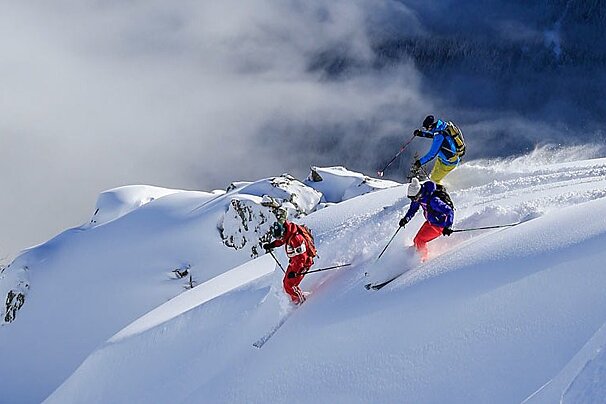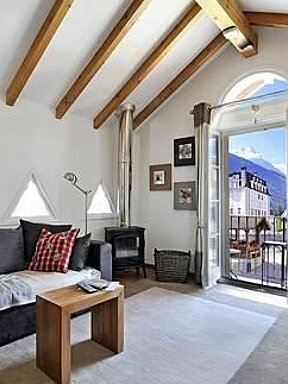
© Tim Oliver

© SeeChamonix.com
La Vallee Blanche Ski Area in Chamonix
Discover the best of the Chamonix Vallee Blanche ski area
The Vallée Blanche starts at the top of the Aiguille du Midi and finishes in Chamonix’s town centre (snow permitting). It’s an unmarked, unmaintained and unpatrolled high mountain off-piste ski itinerary which offers some of the most spectacular scenery that the Mont Blanc range has to offer.
The Aiguille du Midi cable car is the starting point for this popular route. Generally, the lift company operates a number system where you can pre-book your cable car in advance. This is highly recommended if you want to avoid an unpredictable and possibly long wait on a busy day. A Mont Blanc Unlimited pass covers the Aiguille du Midi lift, prices here.
The numerous Vallée Blanche routes start at the top of the Aiguille du Midi (3,812m) where after exiting the ice tunnel you're straight onto the ‘arête’. This is potentially one of the most dangerous points of the route - essentially a ridge edge which has a 50-degree pitch on both sides. In high season, a safety rope is placed along the descending path and steps are usually cut into the slopes, but it's still pretty intimidating knowing a safety rope is all that there is between you and the pea-sized buildings of Chamonix town centre.
There are four main Vallée Blanche routes.
The classic route ‘voie normal’ is fairly straight-forward providing you are following the advice of your hired guide. The route can be fairly busy during high season. The other routes are known as Le Vrai Vallée Blanche, the Petit Envers du Plan and the Grand Envers du Plan. These latter routes are technically more challenging and involve couloir skiing so are for more experienced skiers.
If skiing the ‘voie normal’ after descending the arête, the route heads to the right of the large rock outcrop known as Le Gros Rognon (‘the big rock’). Along the descending route you will see large séracs, crevasses and ice falls which are pretty impressive sparkling away in various shades of icy blue from the winter sunshine.
Most people make a day of the trip and for many it's the highlight of a skiing trip to Chamonix and they want to enjoy it. If you allow for regular breaks and a bit of sightseeing on the way down you will probably take between four and six hours for the round trip from Chamonix. Don’t forget that queues can be long for the Aiguille du Midi télépherique, the arête from the Midi to the glacier, and for the return train from Montenvers.
A popular pit stop for lunch on the Vallée Blanche is the Requin refuge. A number of skiers also tend to stop at the ‘Salle à Manger’ beneath the séracs. These large ice structures can collapse at any time so it's best not to hang around. If you don't want to carry food with you there is a café at the top, at the Aiguille du Midi and at the bottom, at Montenvers.
The route at the end of the Vallée Blanche really favours skiers as it has a long flat run out which can be tricky for snowboarders to keep moving. During the spring it gets pretty slushy too, so it's recommended that snowboarders take a pair of telescopic poles to push themselves along. In good snow conditions you can ski all the way back to Chamonix’s town centre; if not then the best way down is via the gondola and the Montenvers train.
Watch this
The Vallée Blanche - guides, experience, and equipment
What you need to know about the Vallée Blanche
Guides
Guides are not compulsory on the Vallée Blanche, and experienced skiers who know the routes well often make the descent without them. However, if you're here on holiday, it's your first time and you're unsure of your knowledge or ability on glaciated terrain, you should hire one of the many mountain guides that work in the area. They know the VB routes like the back of their hand, can lead you in bad conditions and will minimise the risks involved. Most importantly they will know what is required to rescue you should the unthinkable happen.
Skiing level required
The conditions will define the level of skiing involved. Sometimes there is a firm base and it can be compared to skiing on piste. In that case, it can feel like a blue/red run. However, there may be deep powder, crusty layers or icy moguls, in which case it’s more like a full-on black. Most of the time a skier who is comfortable on any red runs should be able to cope with the easiest of the routes down. Another advantage of hiring a guide is that they will determine the best route for your group's ability.
Equipment required
You need wear a harness when skiing on a glacier. This allows you to be rescued from a crevasse. You will need at least one rope per party and the associated hardware required to perform a rescue (slings, carabiners, ice screws, pulleys etc). But most importantly you should know the correct method of performing a crevasse rescue.
Avalanche transceivers should be worn by all members of your party. These not only allow rescuers to find you in the event of an avalanche but allow you to find others, so knowing how to use this vital piece of kit is the most important part of off-piste skiing.
Shovels and probes are essential off-piste kit that should always be carried when leaving the safety of a piste.
Most guiding companies will be able to provide the above equipment for their clients if confirmed in advance.
Before setting out, it is worth checking:
- The weather forecast
- The avalanche risk
- Your transceiver batteries
- That you have the required equipment
There are always dangers when skiing on glaciers in the high mountains. The main dangers on the Vallée Blanche are crevasse falls and avalanches. Either are potential killers and the descent should not be taken lightly.
If you are not qualified or proficiently experienced to ski on glaciers you should - without question - hire a mountain guide. Do not attempt to follow other guided parties – they may be taking a much more serious route than the one you intend to descend.
More inspiration...
Take a look at this year's ski pass prices for more information on accessing the Vallée Blanche.
































